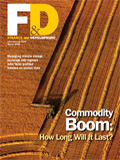 About F&D Subscribe Back Issues Write Us Copyright Information Free Email Notification Receive emails when we post new
items of interest to you. |
From the Editor Pricey Commodities Against this backdrop, the March 2008 issue of F&D delves into the latest commodity boom—which, unlike past booms (in the 1970s, 1980s and 1990s) is taking place within the context of high global growth. In "Riding a Wave," the authors of a recent IMF study argue that, so far, the impact on growth and inflation has been limited—in fact, less than had been feared. But they warn that the impact on headline inflation might persist throughout 2008—even without further increases—and low- and middle-income countries that are net commodity importers might see weaker trade balances. What can be done? The study says policymakers should take steps to ensure the efficient functioning of market forces at the global level—such as allowing free trade in biofuels and incorporating emissions costs in the prices of all fuels—and move swiftly to protect the poorest. * * * * * Of course, these energy recommendations tie in with the global push to limit greenhouse gas emissions and develop alternative fuels as evidence of global warming mounts. The UN's Intergovernmental Panel on Climate Change in December 2007 warned that in the absence of a serious effort to curb emissions, the average global temperature will rise by about 3°C by 2100 from the 1980–99 levels, and higher temperature increases are possible. Even if emissions were sharply curbed, temperatures would still go up because of the large stock of past emissions accumulated in the atmosphere. What will a warmer planet mean for rich and poor countries alike? F&D explores this question in a series of articles by IMF staff and outside experts, who take as their starting point the risks and uncertainties being raised by scientists. We learn that it should be possible for policymakers to address climate change without either hurting macroeconomic stability and growth or putting an undue burden on the countries least able to bear the costs of policies. We learn that there's good reason not to downplay the risks to agriculture—in fact, if steps aren't taken to curb carbon emissions, agricultural productivity will fall dramatically, especially in developing countries. We learn that financial markets are taking off in carbon permit trading, weather derivatives, and catastrophe bonds. And we learn that there are promising tools for integrating climate change responses into sustainable development strategies. Indeed, the existence of these tools should help to dispel concerns that tackling climate change might divert resources that are sorely needed to deal with more immediate development problems, such as growth and poverty. Laura Wallace
|